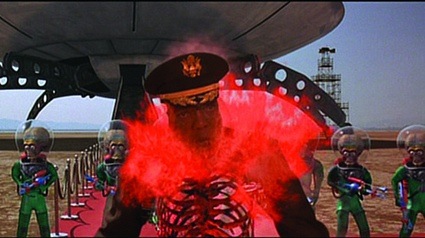 Still from the movie Mars Attacks
Still from the movie Mars Attacks
The latest installation and videos by Demitrios Kargotis and Dash Macdonald are inspired by the exercises performed by members of Casualties Union (CU), a charity organisation funded during the Second World War as a course where acting, made-up casualties were recreated to provide added ‘realism’ to civil defense and rescue training exercises. For over 60 years, their methodologies and exercises have been showing actors how to simulate ‘authentically’ both the emotional shock of disaster and physical trauma.
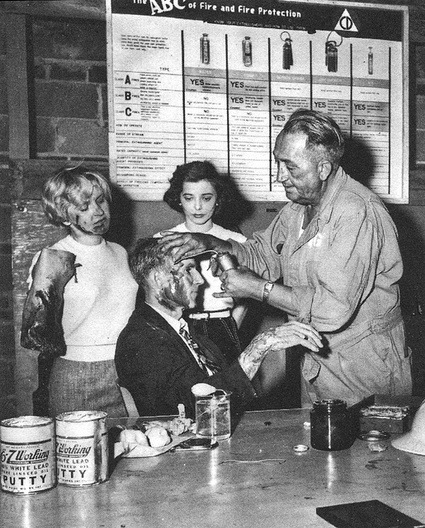 Archive image: The Casualties Union
Archive image: The Casualties Union
The title for this exhibition currently on view at Lanchester Gallery Projects comes from a CU training script for displaying the different emotions associated with disaster; in this case ‘shock’.
Through working with the Casualties Union West Midlands region to produce exercises which test and expand their methodology, the exhibition addresses the reach of theatre into everyday life and the dependence of acting in preparations that constitute applied policy on civil defence.
The first work in the new series, Exercise 1: ‘Trapped Under Piano in Real Time’ is an experiment in endurance acting that challenges a qualified member of the CU to realistically portray the physical and psychological symptoms of their prescribed injuries for as long as possible; exploring the need of acting casualties to sustain an ‘authentic’ performance throughout the entirety of training exercises. The 03:03:35 hour film Contrasts the often ‘hyper-real’, fast paced, edited portrayal of disaster that we are accustomed to through television and film.
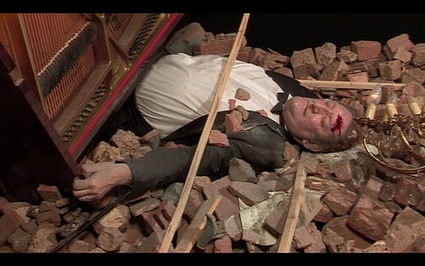
The disaster scene in this first exercise is re-created from a training exercise detailed in the book The Struggle for Peace by Eric Claxton, founder of the Casualties Union.
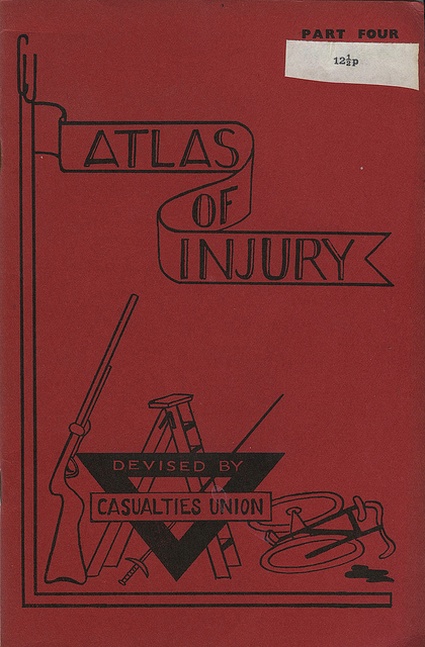
Exercise 2: ‘A Study in Laser Wounds’ reflects the fact that The Atlas of Injury, the CU publication that guides its members how to act, fake and stage the signs and symptoms of injuries with medical accuracy has expanded over the course of the past 60 years in response to technological developments both in warfare and everyday life.
Laser weapons have hit battlefield strength for the first time and although currently used to counter missiles and projectiles, laser technology is on course to develop anti-personnel weapon systems in the years to come. Based on non-classified papers on laser bio-effects such as Explosive Onset of Continuous Wave Laser Tissue Ablation, Kargotis and MacDonald challenged the CU to expand the Atlas of Injury to include the effects of laser weapons on human tissue.
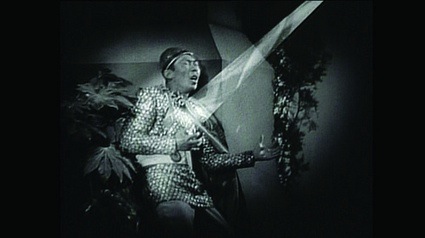 Still from Buck Rogers
Still from Buck Rogers
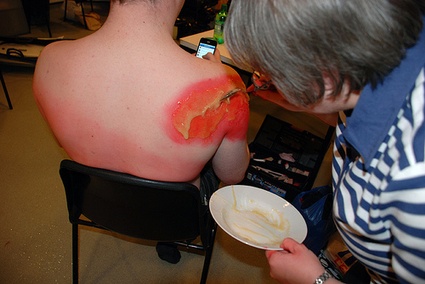
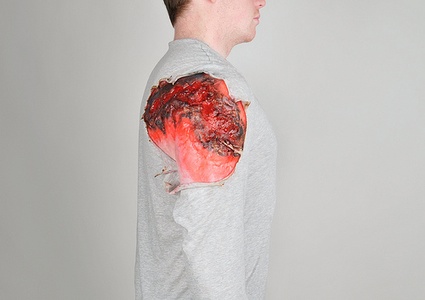
The photographs document three speculative laser wounds starting with the current Advance Tactical Laser, at hundred kilowatts strength with a ten centimeter diameter at the target; moving up to higher power and smaller beam diameters which might be available in the future.
Finally, Exercise 3: ‘Heart Attack in Repetition’ challenged a CU member to repeatedly deliver one of their ‘signature’ injury simulations for the duration of forty minutes. This
performance is based on the role the CU play in training competitions for first aid and rescue organizations such as the Red Cross where CU members have to deliver the
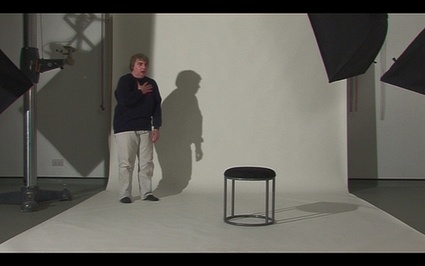
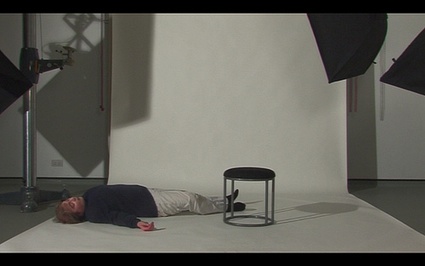
Thime for a quick question and answer exercise with Macdonald and Kargotis!
I had never heard of anything like Casualties Union. How did you discover the existence of this organization?
We initially discussed the CU after reading a short paragraph detailing their activities in JG Ballard’s The Atrocity Exhibition, then rediscovered them when researching into the theatrical nature of civil defense and the different methods used for rehearsing possible disaster.
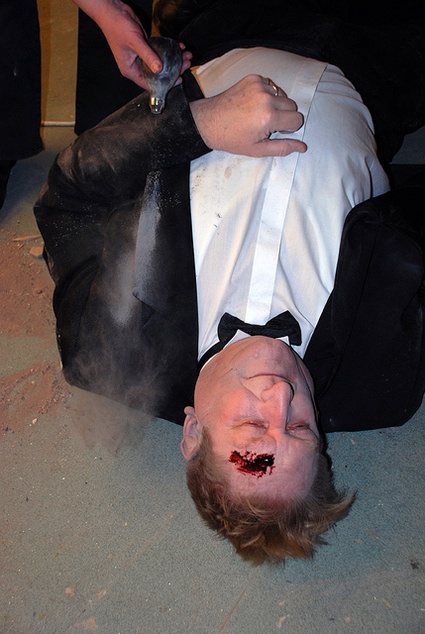 Have you at any point been tempted to train with them and perform the casualties yourself?
Have you at any point been tempted to train with them and perform the casualties yourself?
Actually, in order to get to know the West Midlands Branch of the CU, we attended and offered our services as acting casualties for an exercise at Birmingham’s police training centre. We played a family member of a missing person that could have been involved in a mass casualty disaster abroad. Drawing from a sheet of paper describing the features of our fictitious family member, we sat in one of the academy dorm rooms, that we had to imagine was our house, answering their questions and improvising what we thought was the appropriate level of distress.
It was interesting over discussions at lunch to hear how each CU member had approached this in a different manner from being uncooperative and impatient to quietly sobbing and shaking.
The performances you ask from the members of CU seem to be intense. On the other hand, CU works in a context which is quite different from yours. I had first thought they worked for the cinema industry but their website states that they work for “public benefit education and training in first aid, the treatment of illness, nursing, rescue, accident prevention, care in the community and similar activities”. So how did they welcome this collaboration with you? Were there directions where they were not ready to go?
It’s interesting that you thought they worked for the cinema industry as it was the contrasting demands placed on acting, illusion and pretense in the context of the CU, and their role in rescue training and accident prevention that fascinated us. For example, in such simulations if the rescue and first aid workers experience depends on the casualties’ acting it places a significant need for the delivery of a ‘realistic’ performance as ‘unauthentic acting’ could contribute to ‘unauthentic’ procedure. All the exercises we set for the CU were based on the unique techniques they have pioneered to ‘authentically’ portray casualty victims and they were open and excited by the challenges, and as committed to achieving authenticity and realism as they would be in any of their usual training exercises which can often be intense and physically demanding.
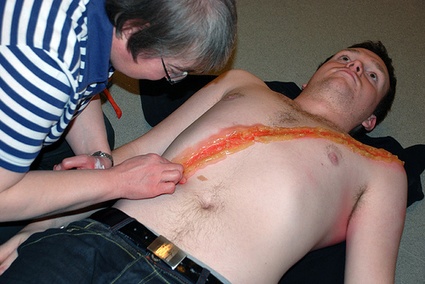 It is not the first time you explores ‘amateur acting/staging skills’. I’m thinking of Imagine Being a World Leader. Is SHOCK: ‘It…all…happened…so…quickly’ a continuation of the former project? Or is it an entirely different investigation?
It is not the first time you explores ‘amateur acting/staging skills’. I’m thinking of Imagine Being a World Leader. Is SHOCK: ‘It…all…happened…so…quickly’ a continuation of the former project? Or is it an entirely different investigation?
Both projects stem from our interest in acting, artifice and scripted pretense and their role in systems that affect our behaviour and perceptions of reality. ‘Imagine Being a World Leader’ uses the primary school children as a medium to deconstruct and show the potency of political rhetoric. SHOCK: ‘It…all…happened…so…quickly’ challenges the idea of authentically simulating reality and the role acting plays in shaping real world policy. However, the two projects focus on the pedagogy of these methods and how understanding them can create debate on the social implications they have.
“The exhibition addresses the reach of theatre into everyday life.’ is this presence of theater into reality something we should embrace or do you feel that this is an invasion that should be kept under control?
In the context of preparing for possible risks and disasters, the CU offers a valuable service for the training of emergency, rescue workers and organizations. In contrast, if we look at their involvement in past Cold War civil defense drills or current large scale simulations of terrorist attacks, they then become a part of what Professor Peter Marcuse refers to as ‘manipulated climate responses’, contrived scenarios that are calculated to increase insecurity for specific political agendas.
Any upcoming project of DASHNDEM you could share with us?
The next stage of our collaboration with the CU is ‘A Fete Worse than Death’ a public event that will utilize the format of a village fete to further explore the art of casualty simulation. The overall narrative of the event will be based on a site specific ‘worse-case’ scenario. Visitors will learn how to simulate the resulting injuries then take part in competitions with categories which could include: holding the most authentic expression of pain for a prolonged period of time, delivering the most authentic emotional outburst or panic reaction or sculpting the most authentic severed limb. The ‘finale’ will consist of an improvised simulation of the overall scenario, staged around the central disaster set supported by accompanying music; a score composed for the scenario performed by a brass band.
Thanks Dash and Demitrios!
DASHNDEM – SHOCK: ‘It… all… happened… so… quickly’ is running at the Lanchester Gallery Projects until 28 January 2011.
All images courtesy DASHNDEM.
See also Tatjana Hallbaum‘s IN-BETWEEN photos as described in the post Manipulating Reality – How Images Redefine the World.
Other work by Demitrios Kargotis: The unhappier you are, the more ice cream you get. By Dash MacDonald: Remote control skates.
